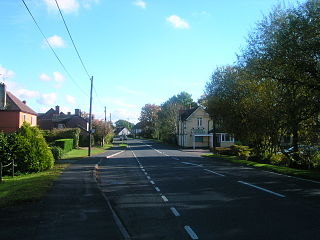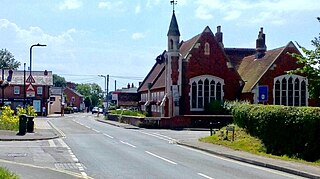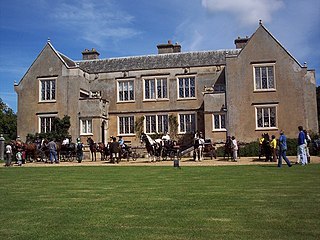
Brockenhurst is the largest village by population within the New Forest in Hampshire, England. The nearest city is Southampton some 13 miles (21 km) to the north-east, while Bournemouth is also nearby, 15 miles (24 km) south-west. Surrounding towns and villages include Beaulieu, Lymington, Lyndhurst, and Sway.

Lyndhurst is a large village and civil parish situated in the New Forest National Park in Hampshire, England. Serving as the administrative capital of the New Forest, it is a popular tourist attraction, with many independent shops, art galleries, cafés, museums, pubs and hotels. The nearest city is Southampton, about nine miles (14 km) to the north-east. As of 2001 Lyndhurst had a population of 2,973, increasing to 3,029 at the 2011 Census. The name derives from an Old English name, comprising the words lind and hyrst.

Holbury is a village in Hampshire, England. It is part of the parish of Fawley.

Cadnam is a village situated in Hampshire, England, within the boundaries of the New Forest National Park. The village has existed since the medieval period, when it was an important crossroads between Southampton and the towns of Dorset.

Hordle is a village and civil parish in the county of Hampshire, England. It is situated between the Solent coast and the New Forest, and is bordered by the towns of Lymington and New Milton. Like many New Forest parishes Hordle has no village centre. The civil parish includes the hamlets of Tiptoe and Everton as well as part of Downton. The parish was originally much larger; stretching from the New Forest boundary to Hurst Castle.

Minstead is a small village and civil parish in the New Forest, Hampshire, about 2 miles (3.2 km) north of Lyndhurst. There is a shop and a pub, the Trusty Servant. Sir Arthur Conan Doyle's grave is under a large tree at the back of the 13th century All Saints' church.
Sybil Leek was an English witch, astrologer, occult author and self-proclaimed psychic. She wrote many books on occult and esoteric subjects, and was dubbed "Britain's most famous witch" by the BBC.

Damerham is a rural village and civil parish in the New Forest district of Hampshire, England, near Fordingbridge. The area has notable Neolithic and Bronze Age barrows. It was the site of an Anglo-Saxon religious community, mentioned in the will of Alfred the Great. By the time of Domesday Book (1086), Damerham was a major settlement in the possession of Glastonbury Abbey. The village has a riverside mill and a Norman church.

Martin is a village and civil parish in the New Forest district of Hampshire, England. The nearest town, Fordingbridge, is 7 miles (11 km) to the south-east, and the cathedral city of Salisbury is 12 miles (19 km) to the north-east.

Hale is a small village and civil parish in Hampshire, England. It lies on the border of the New Forest, overlooking the valley of the River Avon. The village is about 3.5 miles (5.6 km) north-east of the town of Fordingbridge, and about 8 miles (13 km) south of the city of Salisbury. Within the parish stands Hale House, a large 18th-century mansion which was the country house of architect Thomas Archer, who also rebuilt Hale church in 1717.

Pennington is a ward in the New Forest district of Hampshire, England, which is defined based on the boundaries of the earlier manor. Pennington Village is at the centre of the ward, with Upper Pennington to the north and Lower Pennington to the south. The population taken at the 2011 census was 6,060. It is in the southernmost part of the New Forest on the Solent coastline near to the town of Lymington, with which it shares the civil parish of Lymington and Pennington.

Ellingham is a small village near Ringwood in Hampshire, England, west of the New Forest National Park. It is in the civil parish of Ellingham, Harbridge and Ibsley. Ellingham is most famous for the story of Alice Lisle, who was executed by the infamous Judge Jeffreys in 1685, on the charge of harbouring fugitives after the defeat of the Monmouth Rebellion.

Ibsley is a village in Hampshire, England. It is about 2.5 miles (4 km) north of the town of Ringwood. It is in the civil parish of Ellingham, Harbridge and Ibsley.

Harbridge is a small village located some four kilometres north of Ringwood and a similar distance south of Fordingbridge, in southwest Hampshire, England. It is in the civil parish of Ellingham, Harbridge and Ibsley.

Bank is a village in the English county of Hampshire. The settlement is within the civil parish of Lyndhurst in the New Forest, and is located approximately 8 miles (13 km) from both Ringwood and Southampton. It has one inn and approximately 30 distinct dwellings.

Netley Marsh is a village and civil parish in Hampshire, close to the town of Totton. It lies within the New Forest District, and the New Forest National Park. It is the alleged site of the battle between an invading Anglo Saxon army, under Cerdic and a British army under Natanleod in the year 508.

Bisterne is a hamlet in the civil parish of Ringwood in the New Forest National Park in Hampshire, England. Its nearest town is Ringwood, which lies 3 miles (4.8 km) to the north.

Crow is a small village situated in the New Forest National Park in Hampshire, England. Its nearest town is Ringwood, which lies approximately 1 mile (1.6 km) north-west from the village.

Emery Down is a small village in the New Forest National Park in Hampshire, England. Its nearest town is Lyndhurst, which lies approximately 1.4 miles (2.3 km) south-east from the village.
The Bisterne Dragon is a legend from the New Forest in England. The story takes place primarily in Bisterne, but also features Burley and Lyndhurst, and is one of the area's most famous pieces of folklore.




















